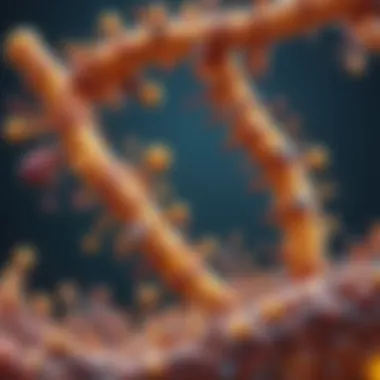Understanding Peroxidase Substrates: A Detailed Review


Article Overview
Summary of Key Findings
Peroxidase substrates play a crucial role in various biochemical processes, acting as the medium through which peroxidases exert their enzymatic functions. This article uncovers several key types of peroxidase substrates, including hydrogen peroxide, phenolic compounds, and aromatic amines. Each of these substrates showcases unique interaction mechanisms with peroxidases, leading to a range of biochemical applications in fields like biochemistry, medicine, and environmental science.
The significance of understanding these substrates is highlighted through their influence on the functionality of peroxidases. Additionally, this analysis reveals recent advances in research, focusing on emerging applications of peroxidase substrates in innovative biotechnological solutions.
Research Objectives
The primary goal of this article is to examine the intricate relationship between peroxidases and their substrates. By doing so, it aims to:
- Clarify the types of peroxidase substrates and their characteristics.
- Explore the mechanisms through which these substrates are processed by peroxidases.
- Discuss the implications of substrate interactions in real-world applications, especially in medicine and environmental contexts.
- Investigate current research trends and future directions concerning peroxidase substrate utilization.
Key Results and Discussions
Main Findings
The findings of this analysis reveal that peroxidase substrates can vary widely in terms of their structure and function. For instance:
- Hydrogen Peroxide: This is one of the most common substrates and acts as a key player in many oxidative reactions. It triggers the activity of various peroxidases, which catalyze its breakdown into water and oxygen, thereby protecting cells from oxidative stress.
- Phenolic Compounds: These substrates are prevalent in plants and are involved in processes like lignin formation and defense against pathogens. Their interaction with peroxidases enhances their antioxidant properties.
- Aromatic Amines: This group of substrates is significant in the field of biochemistry. They are often used in various analytical techniques, and understanding their interaction with peroxidases can lead to advancements in chemical detection methods.
Implications of Findings
The implications of these findings are profound, influencing several areas:
- In medicine, peroxidase substrates have been utilized in creating diagnostic tools and therapeutic agents. Understanding how different substrates interact with peroxidases could lead to more efficient treatments for diseases.
- From an environmental science perspective, the study of peroxidase substrates can enhance bioremediation efforts. They can be employed to break down pollutants and improve soil health.
"Understanding the interaction between peroxidases and their substrates can unlock new pathways for scientific advancement."
By delving deeper into these biochemicals, researchers can pave the way for innovative applications that harness these interactions effectively.
Intro to Peroxidase Substrates
The exploration of peroxidase substrates serves as a cornerstone in understanding numerous biochemical processes. Their role is crucial, bridging the gap between enzymes and the biological reactions they facilitate. Peroxidases are enzymes that catalyze the oxidation of substrates using hydrogen peroxide. Thus, comprehending the substrates these enzymes interact with leads to significant insights into biochemical pathways, environmental science, and medical applications.
Understanding peroxidase substrates extends beyond basic definitions. It involves analyzing their catalytic behavior, substrate affinities, and how various external factors can influence their activity. This section is essential in framing the subsequent discussions surrounding the types of substrates, their mechanisms, and their broader implications in scientific research and industry.
Definition and Importance
Peroxidase substrates are compounds that serve as reactants in peroxidatic reactions. In these processes, peroxidases use hydrogen peroxide to facilitate oxidation. The significance of these substrates cannot be overstated; they play vital roles in detoxifying harmful substances, participating in metabolic pathways, and influencing cellular signaling.
The understanding of peroxidase substrates is pivotal for several reasons:
- Biochemical Mechanisms: Knowledge of substrates aids in elucidating the mechanisms of enzyme action.
- Applications: Recognizing specific substrates helps in field applications such as bioremediation, where peroxidases can degrade pollutants.
- Research Development: Insights into substrate interactions can lead to the development of new biotechnology tools or therapeutic solutions.
This foundation is critical for researchers, students, and professionals in biochemistry and related fields, highlighting the interconnectedness of substrate chemistry and enzyme functionality.
Historical Background
The study of peroxidases and their substrates began in earnest during the late 19th century, with early research attributing significant biological functions to these enzymes. Initially, scientists isolated peroxidases from various plant sources, identifying their role in hydrogen peroxide metabolism. Over the decades, the understanding of these enzymes has evolved dramatically.
By the mid-20th century, research expanded to include identifying different types of peroxidases, such as horseradish peroxidase, which became widely studied due to its commercial applications. This period also marked the transition towards genetic studies, leading to insights into how peroxidases evolved and adapted to different biological contexts.
In recent years, advances in molecular biology techniques have further propelled the investigation of peroxidase substrates. Scientists have begun to explore not only the conventional substrates but also synthetic variations, enhancing our understanding of enzymatic specificity and efficiency.


This historical perspective provides a vital backdrop for the current exploration of peroxidase substrates, illustrating the depth of scientific inquiry and the potential for future discoveries in this fascinating area of research.
Biochemical Mechanisms
Understanding the biochemical mechanisms behind peroxidases is crucial for comprehending how these enzymes interact with their substrates. Peroxidases play an essential role in many biological processes. They catalyze reactions that involve the oxidation of substrates, which is a key function in both physiological and pathological conditions. This section will explore the catalytic activity, electron transfer processes, and substrate-binding interactions of peroxidases.
Catalytic Activity of Peroxidases
The catalytic activity of peroxidases is fundamental to their function. These enzymes utilize hydrogen peroxide as a substrate, facilitating its decomposition while simultaneously oxidizing other substrates. The mechanism involves a series of steps that alternate between oxidized and reduced enzyme states. This cycle allows peroxidases to efficiently convert substrates into products, often with high specificity.
In practical terms, the catalytic activity of peroxidases can be influenced by various factors such as pH, temperature, and substrate concentration. For instance, a shift in pH can alter the enzyme's conformation, impacting its binding affinity and, consequently, its activity. These conditions must be optimized for effective biotechnological applications, making it a subject of extensive research.
Electron Transfer Processes
Electron transfer processes are integral to the function of peroxidases. Enzymatic reactions often require the transfer of electrons from a donor molecule to an acceptor, in this case, from the substrate to hydrogen peroxide. This interaction is what allows the redox reactions to occur.
The structure of peroxidase facilitates these electron transfer steps. Each peroxidase enzyme contains a heme group, which is crucial for the transfer process. The heme iron undergoes oxidation and reduction during the catalytic cycle. Understanding these transfer processes helps researchers design better inhibitors or enhancers for peroxidase activity, which is vital in medicinal and environmental applications.
Substrate-Binding Interactions
Substrate-binding interactions are crucial for the specificity and efficiency of peroxidases. These interactions determine how substrates fit into the active site of the enzyme. Various forces such as hydrogen bonds, ionic interactions, and hydrophobic effects play role in this binding.
The conformation of the substrate can significantly affect these interactions. Certain structural characteristics allow substrates to fit more snugly into the enzyme's active site, thereby promoting catalytic activity. Factors such as molecular size, shape, and charge can influence binding strengths. This specificity in substrate recognition is vital for preventing unwanted reactions, ensuring that only the desired substrates are processed by the enzyme.
"The efficiency of substrate-binding interactions can dictate the overall outcome of biochemical reactions, emphasizing the need for accurate studies in enzyme kinetics."
In summary, the biochemical mechanisms involving peroxidases demonstrate a complex interplay of catalytic activity, electron transfer, and substrate-binding. These elements contribute not only to the understanding of peroxidase function but also to the broader applications in industries ranging from biotechnology to environmental science.
Types of Peroxidase Substrates
Understanding the types of peroxidase substrates is crucial in biochemistry and related fields. These substrates are the molecules that undergo oxidation during the enzymatic reaction facilitated by peroxidases. The knowledge of these substrates enhances our comprehension of various biochemical pathways and their applications in industries such as medicine, biotechnology, and environmental science. Several factors can influence the choice of substrate, including stability, reactivity, and compatibility with specific applications.
Organic Substrates
Organic substrates are predominantly used in peroxidase reactions. These compounds are typically carbon-based and include a variety of molecules such as phenols, amines, and various aromatic compounds. Organic peroxidase substrates are significant for several reasons:
- Reactivity: Organic substrates often have functional groups that can easily participate in redox reactions, making them suitable for peroxidase activity.
- Diversity: The vast array of organic compounds provides a rich resource for research and industrial applications. For instance, guaiacol and pyrogallol are commonly used organic substrates in laboratory settings to assess peroxidase activity.
- Biological relevance: Many organic substrates are naturally occurring compounds that play vital roles in metabolic processes.
These characteristics illustrate the importance of organic substrates in the study and application of peroxidases in various scientific fields.
Inorganic Substrates
Inorganic substrates, though less common than organic ones, also play a role in peroxidase-catalyzed reactions. These substrates can include ions like hydrogen peroxide and other reactive oxygen species. The significance of inorganic substrates can be outlined as follows:
- Active oxygen species: Hydrogen peroxide is a key substrate for peroxidases. It acts as both a product and substrate in different biochemical pathways.
- Utility in assays: Inorganic substrates are often used in analytical procedures to determine peroxidase activity. Their high reactivity makes them suitable for this purpose.
- Environmental applications: Inorganic substrates can also be used in bioremediation efforts to breakdown pollutants in the environment.
Incorporating inorganic substrates into peroxidase research opens new avenues for understanding oxidative reactions across various domains.
Natural vs Synthetic Substrates
The distinction between natural and synthetic substrates is important in peroxidase research. Natural substrates, such as plant phenols, are derived from biological sources and are often involved in physiological processes. Synthetic substrates, on the other hand, are man-made compounds designed to enhance specific reactions or improve analytical sensitivity.
Natural substrates:
- Biocompatibility: Their inherent biological nature makes them suitable for applications in medicine and food industries.
- Real-life relevance: They provide insights into the natural enzymatic processes within various organisms.


Synthetic substrates:
- Tailored properties: These can be modified to achieve specific reaction kinetics, stability, and sensitivity.
- Ease of use: It can be more practical to use synthetic substrates in laboratory settings for standardized assays.
Choosing between natural and synthetic substrates depends on the goals of the research and the specifics of the application. The ongoing exploration of both types continues to reveal new insights into the possible applications of peroxidases in science and industry.
"The choice of substrate can drastically influence the outcome of peroxidase reactions and their real-world applications."
Factors Influencing Peroxidase Activity
The activity of peroxidases is highly dependent on various factors that affect their biochemical behavior. Understanding these factors is pivotal in optimizing their performance in different applications such as biocatalysis, environmental science, and pharmaceutical development. This section outlines the specific elements that influence peroxidase activity, including pH and temperature effects, concentration of substrates, and the presence of inhibitors. These considerations can have significant implications on the efficiency and yield of reactions catalyzed by peroxidase enzymes.
pH and Temperature Effects
pH levels and temperature are critical parameters that significantly influence peroxidase activity. Each peroxidase enzyme has an optimal pH at which its activity is maximized. Deviations from this optimal pH can lead to altered enzyme conformation and decreased catalytic efficiency. For instance, a common peroxidase, horseradish peroxidase, shows optimal activity in a pH range of 6 to 7.5. Similarly, temperature can impact the kinetic activity of the enzyme. Generally, increasing temperature enhances enzyme activity, up to a peak, beyond which denaturation occurs. This implies that maintaining environmental conditions within the right pH and temperature range is crucial for maximizing peroxidase efficacy.
"Optimal conditions for enzymes are crucial as deviations can result in loss of function and overall reaction efficiency."
Concentration of Substrates
The concentration of substrates is another key factor influencing peroxidase activity. As the concentration of the substrate increases, the rate of reaction tends to increase due to more frequent enzyme-substrate interactions. However, this trend only holds true up to a certain point, typically described by the Michaelis-Menten kinetics. After reaching saturation, further increases in substrate concentration do not lead to increased reaction rates. Therefore, balancing substrate concentration is essential for achieving peak enzyme activity without wastage of resources.
Presence of Inhibitors
Inhibitors can significantly affect the activity of peroxidases. These substances can bind to the enzyme and reduce its activity. There are competitive inhibitors that bind to the active site and inhibit substrate binding, as well as non-competitive inhibitors that bind at an alternate site and subsequently distort the enzyme's functionality. Identifying the presence of such inhibitors is crucial for successful application in laboratory and industrial settings. Understanding how different inhibitors interact with peroxidases provides insight into optimizing conditions for enhanced activity.
Applications of Peroxidase Substrates
Peroxidase substrates play a crucial role across various sectors, bridging fundamental biochemical principles with practical applications. Understanding these applications provides insight into how peroxidases contribute to scientific advancements and innovations. This section will delve into three primary fields: biotechnology and bioengineering, pharmaceutical industries, and environmental remediation. The versatility of peroxidase substrates in these areas highlights their importance and influence.
Biotechnology and Bioengineering
In biotechnology, peroxidase substrates find extensive use in processes that require bio-catalysis. They assist in converting substrates into valuable products efficiently. For instance, horseradish peroxidase is commonly employed for various biosensors. This enzyme catalyzes the oxidation of different substrates, leading to detectable signals. Researchers leverage this reaction for applications in food safety and disease diagnostics.
Other applications include the design of bio-based materials. Specific peroxidases can initiate polymerization processes. This is relevant for creating bioplastics with reduced environmental impact.
"The application of peroxidase substrates in biotechnology extends from diagnostics to new materials, reinforcing their significance in scientific research."
Pharmaceutical Industries
In the pharmaceutical field, peroxidase substrates are invaluable for drug formulation and advancement. They help in the synthesis of active pharmaceutical ingredients. The catalytic actions of peroxidases permit selective modifications of organic compounds. This results in more efficient drug development processes.
Moreover, peroxidase substrates aid in creating targeted delivery systems. By utilizing these substrates, researchers can improve the effectiveness and reduce side effects of certain drugs, enhancing patient outcomes.
Environmental Remediation
Environmental remediation utilizes peroxidase substrates to address pollution and contaminants. These substrates facilitate the breakdown of hazardous materials, making them less harmful. For instance, the use of peroxidases in degrading phenolic compounds demonstrates their capability in bioremediation.
Employing peroxidase substrates in soil and water treatment strategies can lead to significant ecological improvements. They can enhance the natural degradation process of pollutants. This not only aids in restoring environments but also promotes sustainable practices in waste management.
The applications of peroxidase substrates underscore their importance in scientific progress. With further understanding and research, these substrates hold potential for even broader implications in various fields.
Recent Advances in Research
The study of peroxidase substrates has seen significant progress in recent years. Researchers are uncovering deeper insights into their biochemical roles, which in turn is enhancing applications across various fields. These advancements are imperative for developing improved substrates and methodologies that can make peroxidases more efficient and versatile.


Innovative Substrate Design
Recent innovations in substrate design focus on creating molecules that can enhance the catalytic activity of peroxidases. For instance, scientists have synthesized modified substrates that demonstrate greater affinity for the active sites of peroxidases. This means they can maximize the efficiency of enzymatic reactions. Furthermore, the use of nanotechnology is aiding these efforts by allowing for better encapsulation and delivery of substrates.
Key considerations in this area include:
- Stability: New substrates must resist degradation during reactions.
- Selectivity: Advanced substrates should preferentially interact with specific peroxidases.
- Cost-Effectiveness: Production methods should be sustainable and economical.
These innovative designs can increase efficiency in diverse applications, ranging from industrial processes to medical diagnostics, showcasing their importance in research and practical uses.
Novel Detection Techniques
Detection techniques for peroxidase substrates are evolving. One notable development is the use of ultra-sensitive biosensors. These sensors can detect substrate interactions at incredibly low concentrations, allowing for high-precision analysis. Additionally, techniques such as fluorescents assays and surface plasmon resonance are becoming mainstream. They help to visualize the interaction between peroxidases and their substrates effectively.
Benefits of these novel detection techniques include:
- Enhanced Sensitivity: Improved detection capabilities allow for smaller samples.
- Real-Time Monitoring: Some techniques enable ongoing observation of reactions.
- Versatility: The methods can be adapted for various types of substrates.
These advances are pivotal as they not only facilitate better understanding of biochemical mechanisms but also contribute to research in environmental science and biotechnology.
"Through recent developments, the field of peroxidase substrate research is expanding, creating new opportunities for innovation and application."
As these advances in research continue, they open doors to potential discoveries that may reshape our understanding of peroxidase substrates and enhance their applications.
Future Directions in the Study of Peroxidase Substrates
The study of peroxidase substrates has reached a pivotal moment. Research in this area is expanding rapidly, prompting new inquiries about the roles these substrates play in biochemical processes. Understanding future directions will not only enhance our knowledge but also open doors to innovative applications. The focus now is divided into two key areas: the potential for new discoveries and the integration with other biochemical processes.
Potential for New Discoveries
The exploration of peroxidase substrates presents grand opportunities for gaining insights into biochemical pathways. Researchers are beginning to identify novel substrates, which can lead to enhanced catalytic efficiency of peroxidases. In particular, the search for compounds with unique reactivity may yield findings that challenge the existing paradigms.
- Novel Natural Substrates: Discovery of new natural peroxidase substrates can illuminate previously overlooked biological roles and pathways.
- Synthetic Innovations: The design of synthetic substrates that mimic natural compounds may significantly improve our understanding of enzyme specificity.
- Genetic Modifications: Advances in molecular genetics enable targeted alterations in peroxidase genes. This may lead to peroxidases that exhibit enhanced performance with specific substrates.
Engaging in these areas can possibly redefine the understanding of enzymatic processes. As new substrates are identified, their potential implications for biotechnology, medication, and environmental applications can be game-changing.
Integration with Other Biochemical Processes
In order to advance peroxidase substrate research, it is crucial to consider the broader context of biochemistry. The integration of peroxidases with other biochemical processes can provide a holistic view of their functionality. These interactions can result in synergistic effects that may maximize efficiency and application.
- Metabolic Pathways: Understanding how peroxidased substrates interact with broader metabolic pathways can uncover important regulatory mechanisms. This may also highlight potential connections with disease pathways.
- Multi-Enzyme Systems: Investigating the role of peroxidases in multi-enzyme systems can lead to discoveries about cooperative catalytic effects. Such knowledge could inform enzyme engineering for industrial applications.
- Environmental Interactions: Studying the interactions of peroxidases with other biochemical processes in ecosystems can elucidate their roles in bioremediation efforts. This is especially relevant for pollution degradation and ecological restoration.
In summary, future research on peroxidase substrates is poised to contribute significantly to various scientific domains, ranging from medicine to environmental sciences. The potential to discover new substrates and integrate knowledge across biochemistry holds promise for groundbreaking advancements.
By focusing on these areas, researchers and scientists can leverage their understanding of peroxidase substrates to make impactful contributions to a range of fields.
End
The conclusion of this article serves as a critical synthesis of the multiple facets of peroxidase substrates. It consolidates the discussions held in previous sections into a cohesive understanding of how these substrates function and their significance across various sciences. By comprehending the biochemical behaviors, types, and applications of peroxidase substrates, one can appreciate their role in enhancing enzymatic reactions, particularly in medical and environmental contexts.
Summary of Key Points
Key points of the article include:
- Definition and Importance: Understanding what peroxidase substrates are and their biochemical relevance.
- Biochemical Mechanisms: Examining catalytic activity and electron transfer processes that underlie peroxidase functions.
- Factors Influencing Activity: Discussing the impact of environmental conditions such as pH and temperature on peroxidase activity.
- Applications: Recognizing diverse applications in biotechnology, pharmaceuticals, and environmental science.
- Recent Advances: Highlighting innovative designs and detection techniques that are evolving in this research area.
"The study of peroxidase substrates is not just an academic exercise; it carries practical implications in technology, medicine, and ecological sustainability."
Final Remarks on Research Implications
The implications of ongoing research into peroxidase substrates are vast. Future investigations may uncover new substrates that enhance enzyme efficiency or highlight potential inhibitors that can modulate enzyme action. This is particularly relevant in the context of developing more effective drugs or environmentally friendly remediation strategies. Moreover, integrating knowledge about peroxidase substrates with other biochemical processes could yield unprecedented insights. The direction of this research could continue to shift paradigms in fields such as synthetic biology and environmental engineering, leading to practical solutions for complex problems.







